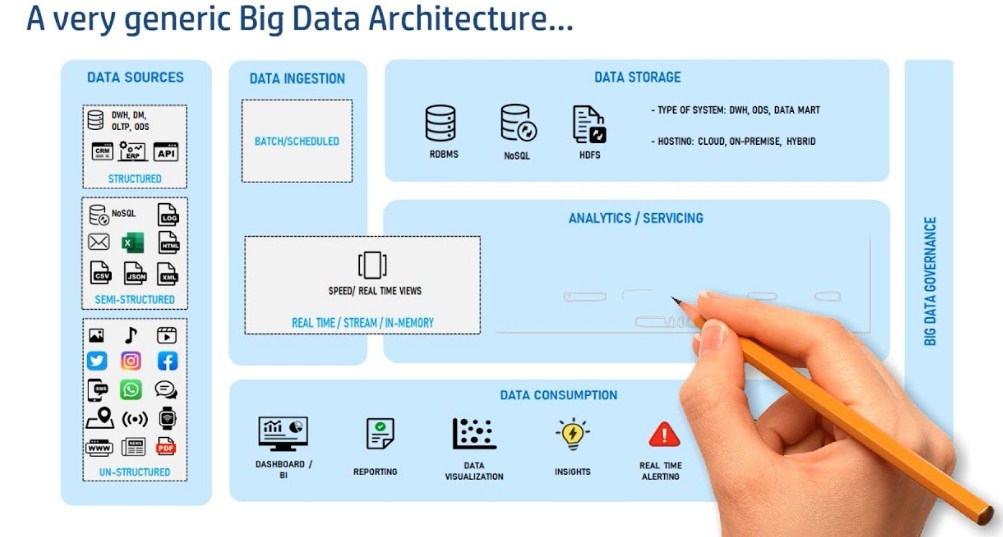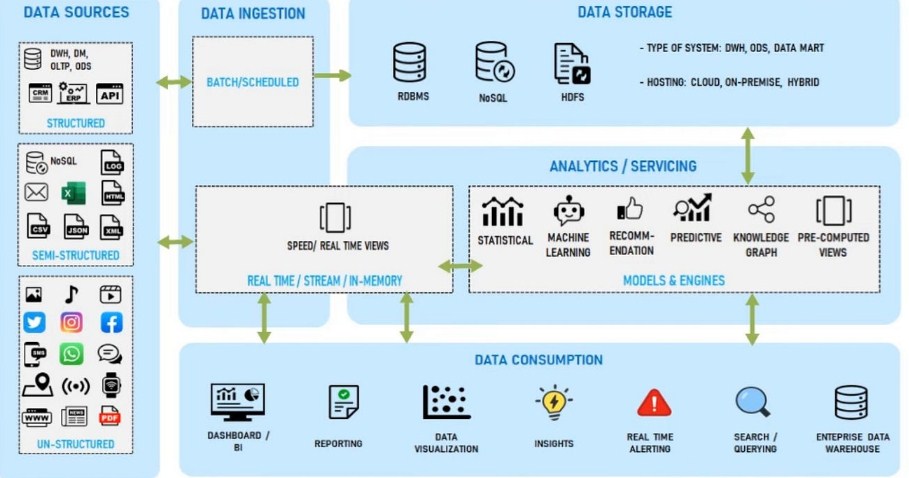Big Data Architectures have become a crucial part of modern enterprises, transforming how businesses handle vast amounts of data. By utilizing powerful technologies, Big Data Architectures provide scalable, flexible, and efficient solutions to process and analyze data at an unprecedented scale.

The growing importance of data in today’s world makes it essential for businesses to implement these architectures to remain competitive and make data-driven decisions.
What is Big Data Architecture?
Big Data Architecture refers to the framework and technologies used to store, process, and analyze large volumes of data. The architecture encompasses various components, including databases, processing frameworks, storage solutions, and tools designed to handle the 3 V’s of Big Data: Volume, Variety, and Velocity.
Key Components of Big Data Architecture
- Data Sources: Where the data originates, such as IoT devices, social media platforms, transactional systems, etc.
- Data Storage: Centralized systems (like Hadoop Distributed File System) for storing large datasets.
- Data Processing: Frameworks like Apache Spark and MapReduce process the data for analysis.
- Data Analysis: Tools such as machine learning models and analytics platforms help derive insights from the data.
- Data Presentation: Dashboards or visualizations to present insights clearly.
Why Big Data Architectures Are Important
1. Enhanced Decision Making
With Big Data Architectures, organizations can make data-driven decisions based on real-time insights. Analytics tools process and analyze large datasets quickly, offering executives the information needed to drive strategy.
2. Scalability and Flexibility
Big Data Architectures are designed to scale easily, meaning they can handle growing data volumes without performance degradation. They can adapt to new data types and formats without the need for a complete overhaul.
3. Cost Efficiency
Cloud-based Big Data solutions are often more cost-effective than traditional on-premise solutions because they allow businesses to only pay for what they use.
4. Improved Customer Experiences
Businesses can use insights from Big Data to offer more personalized customer experiences. Predictive analytics help anticipate customer needs and behavior, allowing companies to provide timely offers and solutions.
Top 5 Big Data Architecture Products

1. Apache Hadoop
Apache Hadoop is one of the most widely used frameworks for processing large datasets in distributed computing environments. It enables organizations to store massive datasets and analyze them using parallel processing techniques.
Features:
- Distributed storage with HDFS
- Scalable and fault-tolerant
- Open-source, which lowers costs
Pros:
- Handles huge datasets effortlessly
- Strong community support
- Integration with other Big Data tools
Cons:
- Complex setup and maintenance
- Requires specialized knowledge
Use Case:
Ideal for companies dealing with large amounts of unstructured data, like social media platforms or IoT applications.
Price:
Free (open-source)
2. Google BigQuery
Google BigQuery is a fully-managed, serverless data warehouse that allows organizations to analyze massive datasets in real time. It’s designed to handle Big Data at lightning speed, with a focus on user-friendliness.
Features:
- Real-time analytics
- Serverless architecture
- Fully managed, no infrastructure to maintain
Pros:
- Fast querying with SQL-like syntax
- No need for manual scaling
- Fully integrated with Google Cloud tools
Cons:
- Can become expensive with heavy usage
- Limited to Google Cloud ecosystem
Use Case:
Best for businesses already using Google Cloud and those needing real-time analytics.
Price:
Pay-per-query pricing (starting from $5 per TB processed)
3. Amazon EMR
Amazon Elastic MapReduce (EMR) is a cloud-native Big Data platform that simplifies processing vast amounts of data. It is an ideal solution for businesses leveraging Apache Spark and Hadoop frameworks for large-scale data processing.
Features:
- Fully managed cluster platform
- Supports Apache Spark, Hive, and HBase
- Integration with AWS ecosystem
Pros:
- Scalable and flexible
- Reduced operational overhead
- High performance
Cons:
- Pricing complexity
- Can be hard to configure for beginners
Use Case:
Perfect for businesses running large-scale machine learning or data analytics workloads in the cloud.
Price:
On-demand pricing with a pay-per-use model.
4. Microsoft Azure HDInsight
Azure HDInsight is a cloud-based service from Microsoft designed for processing Big Data using open-source frameworks like Hadoop and Spark. It integrates with Azure’s ecosystem, providing an easy-to-use environment for Big Data processing.
Features:
- Fully managed
- Supports Hadoop, Spark, Hive, and more
- Deep integration with other Azure services
Pros:
- Seamless integration with Microsoft tools
- Managed service with minimal setup
- Scalable and flexible
Cons:
- Can be expensive for small workloads
- Steeper learning curve for beginners
Use Case:
Ideal for businesses already utilizing Microsoft Azure services or those requiring a flexible, managed Big Data solution.
Price:
Pay-as-you-go pricing model.
5. Cloudera Data Platform (CDP)
Cloudera Data Platform is an enterprise-grade Big Data solution offering end-to-end data engineering, data warehousing, machine learning, and analytics on a single platform. It is designed to support both cloud and on-premises deployments.
Features:
- Unified data management
- Strong security features
- Advanced analytics capabilities
Pros:
- Comprehensive solution with broad integrations
- Excellent security and governance features
- Suitable for hybrid and multi-cloud deployments
Cons:
- High learning curve
- Expensive for small businesses
Use Case:
Best for enterprises requiring end-to-end data management and those working in highly regulated industries.
Price:
Contact for custom pricing (enterprise-focused)
Comparison Table: Big Data Architectures
| Product | Use Case | Pros | Cons | Price |
|---|---|---|---|---|
| Apache Hadoop | Large-scale unstructured data processing | Open-source, scalable, flexible | Complex to set up, requires expertise | Free (Open-source) |
| Google BigQuery | Real-time data analytics | Fast, serverless, SQL-like interface | Pricing can scale quickly, Google Cloud dependency | $5 per TB processed (Pay-per-query) |
| Amazon EMR | Cloud-based large-scale data processing | Flexible, integrates with AWS tools | Pricing complexity, hard to configure | Pay-as-you-go pricing |
| Azure HDInsight | Integrated with Microsoft services | Easy management, scalable, integrated | Expensive for smaller workloads, complex | Pay-as-you-go pricing |
| Cloudera Data Platform (CDP) | End-to-end data management & analytics | Strong security, enterprise-ready | Expensive, steep learning curve | Custom pricing (enterprise-level) |
Benefits of Big Data Architectures
- Data-Driven Insights Big Data Architectures enable businesses to extract actionable insights from vast amounts of data, enhancing decision-making and giving a competitive edge. 🚀
- Cost Optimization Cloud-based Big Data solutions, like Google BigQuery and Amazon EMR, allow businesses to pay only for what they use, helping optimize costs without sacrificing performance. 💡
- Real-Time Analytics Products like Google BigQuery allow businesses to access real-time insights, which is critical for industries such as finance and e-commerce. 🕒
- Scalability Big Data Architectures grow with your business. With solutions like Apache Hadoop, companies can expand their storage and processing capabilities as their data needs increase. 📈
How to Buy Big Data Architecture Products
- Google BigQuery: Available directly through Google Cloud Console. You can start a free trial to test its capabilities. Sign up here.
- Amazon EMR: Start using EMR on AWS by signing up for an AWS account. Explore EMR.
- Azure HDInsight: Available through the Microsoft Azure portal. Get started here.
- Cloudera Data Platform: Contact Cloudera for enterprise-level pricing and setup. Learn more.
Frequently Asked Questions (FAQs)
- What is Big Data Architecture? Big Data Architecture refers to the systems and technologies used to handle vast amounts of data. It involves storage, processing, and analytics frameworks to derive insights from data.
- What are the benefits of using Big Data Architectures? The key benefits include enhanced decision-making, scalability, cost-efficiency, and improved customer experiences.
- Which is the best Big Data Architecture solution for a small business? Solutions like Google BigQuery and Amazon EMR are cost-effective for small businesses due to their pay-per-use pricing models.
- Is Big Data Architecture only for large enterprises? No, many solutions, such as Google BigQuery and Amazon EMR, offer scalable pricing that works for small and medium businesses as well.
- How can I get started with Big Data Architectures? You can start by signing up for cloud-based platforms like Google BigQuery, Amazon EMR, or Azure HDInsight. Most platforms offer free trials or pay-as-you-go models.
This detailed article serves as an informational, benefit-oriented, and transactional guide on Big Data Architectures. It outlines key products, benefits, pricing, and where to buy, catering to businesses looking to optimize their data strategies.
Read More >>>
- Big Data Cloud Migration: Benefits, Solutions, and the Best Tools to Leverage in 2025
- Mastering Big Data Architecture on Azure: Benefits, Products, and How to Get Started